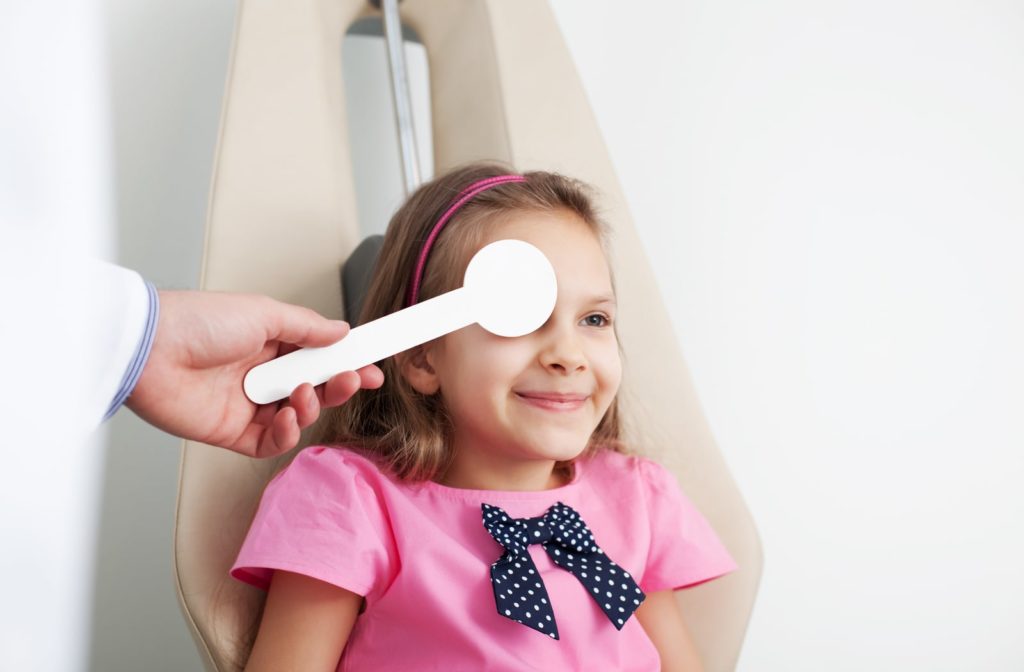Taking your child to their first eye exam can be an exciting, but nerve-wracking experience. No parent wants their child to struggle with learning issues, since 80% of what they learn is visual.
The good news is that eye exams are the most effective way to detect and treat eye conditions and diseases, so taking your child for an optometric visit is great for their vision and ocular health.
This whole process will feel less intimidating once you know what to expect. We’ve outlined the basics of your child’s eye exam so you can feel confident in their eye care.
Eye Exams for Children
Visiting the optometrist will help keep your child’s vision clear and comfortable, and protect their ocular health. If your child is nervous, you can talk to your optometrist about being with them for each part of the appointment.
Your optometrist will look for a number of things, such as:
- Myopia, or nearsightedness, causes objects at a distance to appear blurry
- Hyperopia, or farsightedness, causes objects up close to appear blurry
- Astigmatism occurs when the eye is irregularly shaped
- Amblyopia, which occurs when one eye is “lazy”
- Strabismus, which occurs when the eyes are “crossed”
Your child should come in for an eye exam at least once a year, every year. The tests and exams performed are essentially the same, but it’s still important to monitor your child’s vision and eye health during this time as it can constantly change.
Each eye exam can be different because each patient, and each set of eyes, is different. Your child will likely participate in assessments like:
- Applanation Tonometry: measures eye pressure
- Corneal Topography: maps the curve of the cornea
- Refraction Assessment: measures eye prescription
- Slit-Lamp Exam: illuminates inner eye structures to detect signs of eye disease
- Fundus Photography: takes a picture of the retina
- Visual Acuity: measures focusing ability at varying distances
- Visual Field Test: measures peripheral vision
Your optometrist can make necessary adjustments to the exams to fit your child’s comfort and reading level and how they communicate, such as pictures or symbols instead of letters on a chart.
Signs Your Child May Need Glasses
A child may not realize their vision is “off” simply because they have no frame of comparison. If the whiteboard appears blurry, a child may assume that’s “just how it looks.”
Some signs and symptoms to watch for that could indicate a vision issue in your child include:
- Squinting
- Head tilting
- Sitting close to their screens
- Excessive blinking
- Rubbing their eyes frequently
- Frequent headaches
- Difficulty concentrating
If your child experiences any of these symptoms, or you notice any of these signs, it’s best to take them to see your optometrist.
What Is Myopia Control?
Myopia control, or myopia management, is an area of speciality eye care that focuses on slowing the progression of nearsightedness in children. Myopia, or “nearsightedness,” is a refractive error that causes objects at a distance to appear blurry and usually begins to develop in childhood.
With myopia control, your optometrist can recommend certain treatments to help slow the progression of myopia in your child. While these treatments can’t “cure” or reverse myopia, they can be effective in preventing your child’s prescription from increasing.
When myopia reaches a “severe level” (usually a -6.00 or higher in either eye), it can put a person at a higher risk of developing certain conditions or experiencing eye trauma, such as retinal detachment. Preventing the progression of myopia not only protects your child’s vision from worsening but can also combat eye damage.
Talk to your optometrist to see if myopia control is right for your child.
Healthy Habits for Young Eyes
Annual Eye Exams
The best thing you can do for your child’s vision is to schedule and attend annual eye exams. Many eye conditions and diseases don’t show symptoms in early development, and treatment is most effective when started early.
Eye exams are the only way to take a proactive approach to eye disease diagnosis and management. Annual eye exams also help your child continually see clearly and comfortably, which is imperative for their education and development.
Wash Their Hands
Regularly washing their hands will help your child prevent eye infections. Rubbing their eyes after playing outside could easily lead to ocular issues, and they may not even think of it at the time. Encourage your child to wash their hands regularly and try to teach them to avoid touching their face until after they’ve washed their hands.
Healthy Meals & Snacks
As you probably know, food and diet are directly linked to a person’s general health. When it comes to eye health, this narrative remains true.
Foods rich in vitamin C, such as strawberries or broccoli, help protect the eyes by absorbing some UV rays. Encourage your child to choose fruits and vegetables as healthy snacks. This habit will benefit them for many years to come.
Wear Sunglasses
It’s never too early to start wearing sunglasses. Sunglasses help protect your child’s eyes from harmful UV rays. You should also teach your child to never look directly at the sun.
Limit Screen Time
Digital screens are a part of life, including a child’s life. Whether it’s at home or school, your child is likely exposed to screens throughout the day. Try to limit screen time at home to protect their eyes and ocular health. Also, some studies are showing that blue light from our screens can be harmful to the eyes.
Is It Time for Your Child’s Next Appointment?
If your child hasn’t been to the optometrist in a while, or you’ve noticed changes in their vision or behaviour, it might be time for an eye exam.Our team is here to help. Book your child’s next exam with us today!




